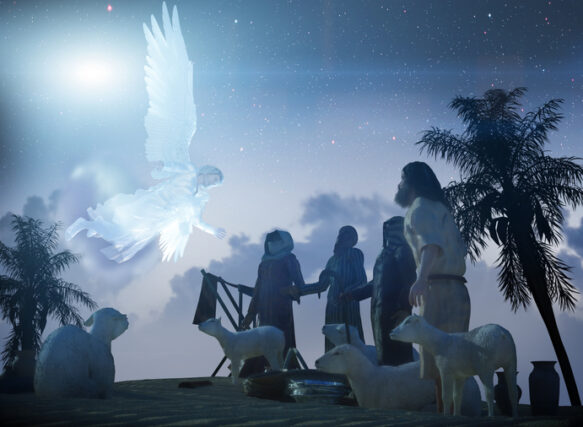While Christmas Day has been celebrated as Jesus’s birthday for centuries, there are reasons many believe the date of 25th December may not be accurate.

Of course, the holiday has become more symbolic than literal, with people using the day to celebrate togetherness with their families and the birth of their saviour — even if it didn’t happen on that exact day. Nevertheless, there’s plenty of reason to believe that Christmas Day isn’t when Jesus was born at all. In fact, he might not have been born anywhere near that date.
1. The Bible doesn’t give a specific date.

Nowhere in the Gospels does it mention Jesus’s exact birthdate The story of his birth in Matthew and Luke provides details about the event but doesn’t include a date, leaving scholars and historians to speculate based on context clues. The absence of a specific date leaves the door wide open for interpretation and debate.
2. Shepherds wouldn’t typically be in the fields in December.

According to the Gospel of Luke, shepherds were watching their flocks at night when Jesus was born. Many believe this would have been unlikely in the cold winter months, as shepherds typically brought their sheep in for the winter around November. The image of sheep grazing in the open fields fits better with warmer seasons like spring or early autumn.
3. December weather in Bethlehem is too cold for travel.

The journey of Mary and Joseph to Bethlehem, described in the Nativity story, would have been pretty tough in winter. Some suggest the census mentioned in the Bible would have taken place in milder weather when travel conditions were more favourable. The harsh winter climate would have made such a journey both dangerous and impractical.
4. The Roman census timing raises questions.

The census that brought Mary and Joseph to Bethlehem likely took place in the warmer months, when people could travel more easily. Some historians argue that holding a census in the dead of winter would have been impractical for the Roman authorities. Collecting accurate data would have been challenging if people were unable to travel due to weather conditions.
5. Early Christians didn’t celebrate Christmas in December.

The earliest recorded celebrations of Jesus’s birth happened in the spring or autumn. It wasn’t until the 4th century that the Roman Church settled on 25th December, suggesting that the date was chosen for reasons beyond historical accuracy. This late decision highlights how cultural and religious factors influenced the chosen date.
6. The date may have been chosen to align with pagan festivals.

Many believe 25th December was selected to coincide with popular pagan festivals, like the Roman Saturnalia or the winter solstice celebrations. This allowed early Christians to integrate their observances with existing cultural traditions. Aligning Christmas with these festivals likely helped ease the transition for new converts.
7. The “Star of Bethlehem” may point to a different season.

Some astronomers suggest that celestial events, like planetary alignments, which could explain the Star of Bethlehem, occurred in the spring or autumn. These theories challenge the idea of a December birth and suggest alternative dates. The timing of these astronomical events offers a plausible reason to question the traditional date.
8. The Jewish calendar indicates other possibilities.

Some researchers link Jesus’s birth to significant Jewish festivals, like Passover in the spring or the Feast of Tabernacles in the autumn. These dates would have cultural and religious significance, fitting well within the context of his birth story. Aligning with these festivals would also tie Jesus’s birth to broader themes of redemption and deliverance.
9. Early church leaders debated the date.

Several early Christian writers, including Clement of Alexandria, mentioned different dates for Jesus’s birth, ranging from March to November. The lack of consensus shows that December 25th wasn’t universally accepted until much later. The ongoing debate highlights the uncertainty surrounding the exact timing of the event.
10. Eastern Orthodox traditions celebrate in January.

Many Eastern Orthodox churches celebrate Christmas on 7th January, following the Julian calendar. This variation further supports the idea that the exact date of Jesus’s birth has been open to interpretation and regional influence. The existence of multiple dates suggests flexibility in the way early Christians marked the occasion.
11. The symbolism of light overcoming darkness.

The choice of December 25th may have been symbolic, aligning with the winter solstice when days start to grow longer. The metaphor of light overcoming darkness fits well with the idea of Jesus bringing hope and salvation to the world. The timing gave spiritual significance to the idea of renewal and rebirth.
12. The shepherds’ presence suggests a different season.

The mention of shepherds tending their flocks at night implies lambing season, which typically happens in spring. Some believe this detail hints that Jesus’s birth occurred during a warmer time of year, rather than in winter. The practicality of keeping sheep in the fields aligns better with a season of growth and renewal.
13. Historical records are sparse and inconsistent.

Accurate historical records from the time of Jesus’s birth are limited, making it difficult to pinpoint an exact date. The reliance on oral traditions and interpretations leaves room for debate and uncertainty about when he was born. The lack of concrete evidence means that any date is ultimately speculative.
14. The emphasis on tradition over historical accuracy.

For many, the importance of celebrating Christmas on 25th December lies in tradition rather than historical fact. The date has been woven into centuries of culture and customs, making it a meaningful occasion regardless of its historical accuracy. The significance of the celebration often outweighs the need for precise dating.




